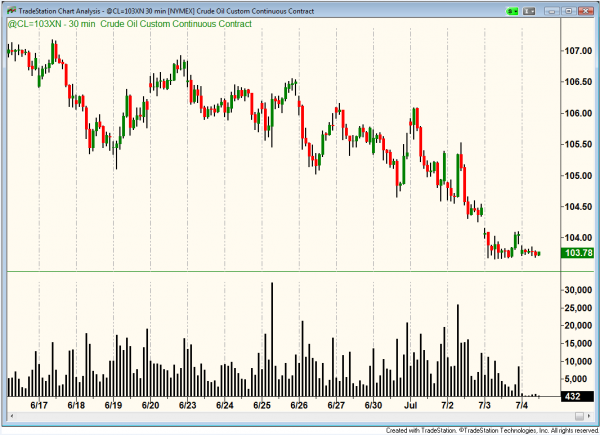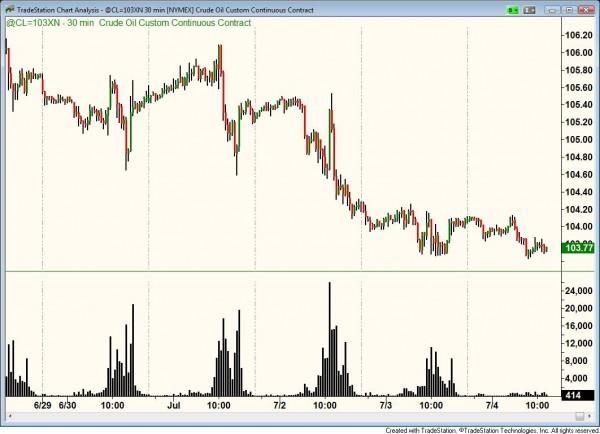Today’s Futures markets are divided up into multiple sessions. Unlike when I started trading there was primarily a daily chart only, no intra-day data was available unless you kept point and figure charts manually of intra-day price movements as many floor traders used to do. There was no electronic trading prior to or after a pit trading session. This meant all of the day’s activity was squeezed into about 7 or 8 hours of trading. The nice thing was that this increased volatility because Commercials had to make their big trading decisions during these same short hours. Today with the Financial Futures and some of the physical Commodities they are almost trading 24 hours per day, market participants are not confined to just the shorter 7 or 8 hours of a pit trading session.
When trading Futures contracts, traders are often faced with the dilemma of which session to use for trading. With electronic Futures trading the markets are now trading during times when the United States market participants are not as actively trading, this dramatically reduces the volume in a Futures contract. These two sessions are:
Regular Trading Hours (RTH) – Trades during the highest volume session
Extended Trading Hours (ETH) – Trades prior to and just after the highest volume session (Also called the Globex Session by some)
Both of these trading sessions can yield good trading levels, but there are times when the ETH session has such low volume that it makes it very difficult to find a good level to place a trade at. Therefore some traders prefer to use the RTH session to create their trading levels from. I can see validity for looking at both charts.
Gaps are much more common on an RTH chart and can create some strong levels for traders. However, sometimes these gaps can be large. When price begins to retrace back to these gaps there can be days of trading between the gap closing and opening prices in which there are no candles to the left. If the trader was looking at an ETH chart there may be candles trading between the gap during the night sessions, possibly creating some trading levels.
Since the RTH session plots data during the highest volume time of the day then the levels that get created will tend to be stronger because of the larger number of orders used to create the level and therefore possibly still have some remaining orders when price returns.
Each trader will have to decide if they find value in one or the other session or possibly both sessions. By back testing your levels over some historical data you should be able to form this decision.
Trade Station users can look at RTH charts for Stock Indexes and the 10 Year Treasury contract by entering their symbols, these are referred to as “.D” charts. Unfortunately there are no other markets that you can view the RTH sessions only by typing in their symbol. You can though create something called custom time sessions with Trade Station so you can view RTH charts of any market you wish.
Figure 1 illustrates an ETH and RTH session combined, All Session chart.
Notice the lower volume during much of the ETH session trading, but when the RTH session starts the volume spikes.
Figure 2 illustrates an RTH chart with only the highest volume periods of the day plotted.

Once you learn to create these time sessions you too will be able to see the difference between night and day in the Futures markets.
The following instructions were created by one of our outstanding Futures instructors, Craig Weil. If you click on his name you can see his bio and his trading experience from the trading floors of Chicago which certainly qualifies him to understand the Futures markets. Thank you for sharing this Craig.
How To Create An RTH Session Chart On Trade Station
(Instructions below are for the Crude Oil –CL contract)
Open An Intra-day 60 Minute Chart Of CL
Right Click On Chart And Choose Format Symbol
Choose Properties
Choose Session
Choose Use Custom Session
Choose Create
Name Your Session (I.E. – Energy RTH)
Choose Add
Name Your Session The Same As Step 7
Choose Monday for Start Day
Choose Start Time of 9:00AM (time is based on Exchange Time)Choose Monday for End Day
Choose End Time of 2:30PM (time is based on Exchange Time)
Check Box For “use this session as End of Day marker”
Choose OK
Choose Add — Monday-Friday
Choose OK
Choose OK
Choose OK
Other sessions you may want to create: Note, times are Exchange Time
This content is intended to provide educational information only. This information should not be construed as individual or customized legal, tax, financial or investment services. As each individual's situation is unique, a qualified professional should be consulted before making legal, tax, financial and investment decisions. The educational information provided in this article does not comprise any course or a part of any course that may be used as an educational credit for any certification purpose and will not prepare any User to be accredited for any licenses in any industry and will not prepare any User to get a job. Reproduced by permission from OTAcademy.com click here for Terms of Use: https://www.otacademy.com/about/terms
Editors’ Picks
AUD/USD gains momentum above 0.6500 ahead of Australian Retail Sales data

AUD/USD trades in positive territory for six consecutive days around 0.6535 during the early Asian session on Monday. The upward momentum of the pair is bolstered by the hawkish stance from the Reserve Bank of Australia after the recent release of Consumer Price Index inflation data last week.
EUR/USD holds positive ground above 1.0700, eyes on German CPI data

EUR/USD trades on a stronger note around 1.0710 during the early Asian trading hours on Monday. The weaker US Dollar below the 106.00 mark provides some support to the major pair.
Gold trades on a softer note below $2,350 on hotter-than-expected US inflation data

Gold price trades on a softer note near $2,335 on Monday during the early Asian session. The recent US economic data showed that US inflationary pressures staying firm, which has added further to market doubts about near-term US Federal Reserve rate cuts.
Ethereum fees drops to lowest level since October, ETH sustains above $3,200

Ethereum’s high transaction fees has been a sticky issue for the blockchain in the past. This led to Layer 2 chains and scaling solutions developing alternatives for users looking to transact at a lower cost.
Week ahead: Hawkish risk as Fed and NFP on tap, Eurozone data eyed too

Fed meets on Wednesday as US inflation stays elevated. Will Friday’s jobs report bring relief or more angst for the markets? Eurozone flash GDP and CPI numbers in focus for the Euro.
RECOMMENDED LESSONS
Making money in forex is easy if you know how the bankers trade!
Discover how to make money in forex is easy if you know how the bankers trade!
5 Forex News Events You Need To Know
In the fast moving world of currency markets, it is extremely important for new traders to know the list of important forex news...
Top 10 Chart Patterns Every Trader Should Know
Chart patterns are one of the most effective trading tools for a trader. They are pure price-action, and form on the basis of underlying buying and...
7 Ways to Avoid Forex Scams
The forex industry is recently seeing more and more scams. Here are 7 ways to avoid losing your money in such scams: Forex scams are becoming frequent. Michael Greenberg reports on luxurious expenses, including a submarine bought from the money taken from forex traders. Here’s another report of a forex fraud. So, how can we avoid falling in such forex scams?
What Are the 10 Fatal Mistakes Traders Make
Trading is exciting. Trading is hard. Trading is extremely hard. Some say that it takes more than 10,000 hours to master. Others believe that trading is the way to quick riches. They might be both wrong. What is important to know that no matter how experienced you are, mistakes will be part of the trading process.


